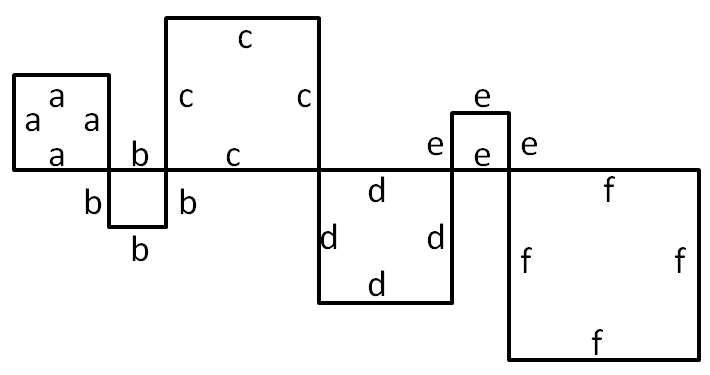Skip over navigation
 Each square has exactly $\frac{1}{4}$ of its perimeter as part of the line, and together these form the whole line. This means the total perimeter is $4 \times 24\text{cm} = 96\text{cm}$.
Each square has exactly $\frac{1}{4}$ of its perimeter as part of the line, and together these form the whole line. This means the total perimeter is $4 \times 24\text{cm} = 96\text{cm}$.
Algebraically, the diagram on the left shows that the line has length $a+b+c+d+e+f = 24\text{cm}$. The total of the perimeters is then:


Or search by topic
Number and algebra
Geometry and measure
Probability and statistics
Working mathematically
Advanced mathematics
For younger learners
Line of Squares
Age 11 to 14
ShortChallenge Level 





- Problem
- Solutions
 Each square has exactly $\frac{1}{4}$ of its perimeter as part of the line, and together these form the whole line. This means the total perimeter is $4 \times 24\text{cm} = 96\text{cm}$.
Each square has exactly $\frac{1}{4}$ of its perimeter as part of the line, and together these form the whole line. This means the total perimeter is $4 \times 24\text{cm} = 96\text{cm}$.Algebraically, the diagram on the left shows that the line has length $a+b+c+d+e+f = 24\text{cm}$. The total of the perimeters is then:
$4a+4b+4c+4d+4e+4f = 4\left(a+b+c+d+e+f\right) = 4 \times 24\text{cm} = 96\text{cm}$
This problem is taken from the UKMT Mathematical Challenges.
You can find more short problems, arranged by curriculum topic, in our short problems collection.
You may also like
Consecutive Numbers
An investigation involving adding and subtracting sets of consecutive numbers. Lots to find out, lots to explore.
Days and Dates
Investigate how you can work out what day of the week your birthday will be on next year, and the year after...

